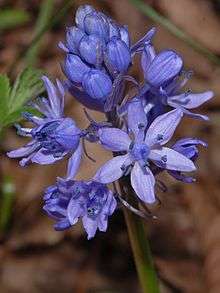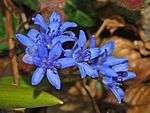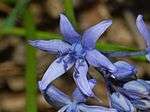Hyacinthoides italica
Hyacinthoides italica, the Italian bluebell or Italian squill, is a spring-flowering bulbous perennial plant belonging to the family Asparagaceae.[2][3]
| Italian bluebell | |
|---|---|
 | |
| Inflorescence of a wild Hyacinthoides italica | |
| Scientific classification | |
| Kingdom: | Plantae |
| Clade: | Tracheophytes |
| Clade: | Angiosperms |
| Clade: | Monocots |
| Order: | Asparagales |
| Family: | Asparagaceae |
| Subfamily: | Scilloideae |
| Genus: | Hyacinthoides |
| Species: | H. italica |
| Binomial name | |
| Hyacinthoides italica (L.) Chouard ex Rothm. | |
| Synonyms[1] | |
| |
It is one of around 11 species in the genus Hyacinthoides, others including the common bluebell (Hyacinthoides non-scripta) in northwestern Europe, and the Spanish bluebell (Hyacinthoides hispanica) further west in the Iberian Peninsula.[4]
Description
Hyacinthoides italica is up to 10–40 centimetres (3.9–15.7 in) tall. The stem is leafless. It has 3-6 basal lance-shaped leaves, 4–15 millimetres (0.16–0.59 in) wide and 7–15 centimetres (2.8–5.9 in) long. The inflorescence is a dense, conical or pyramid-like raceme with 5-30 bright violet-blue star-like flowers. The flowers have two narrow bracts. Flowering period extends from February to May.[5][6][7]
It is in some respects intermediate between the common and Spanish species in having slender leaves (as in H. non-scripta or even slenderer), but a dense raceme of flowers (as in H. hispanica; not sparse and one-sided as in H. non-scripta).
H. italica is sometimes used as an ornamental plant. It has gained the Royal Horticultural Society's Award of Garden Merit.[8][9]
Distribution
This species is native to the central Mediterranean region, in northwestern Italy, in western Liguria, in southern France and in northeastern Spain.[10]
Habitat
It can be found in olive groves, in dry and stony meadows and in clearings of forests at an elevation up to 1,700 metres (5,600 ft) above sea level.
Gallery
 Illustration from The Botanical Magazine, Plate 663
Illustration from The Botanical Magazine, Plate 663 Plants of Hyacinthoides italica in the botanic garden of Berne
Plants of Hyacinthoides italica in the botanic garden of Berne Flowers of Hyacinthoides italica
Flowers of Hyacinthoides italica Close-up of a flower
Close-up of a flower
References
- Catalogue of life
- International Plant Names Index
- Biolib
- World Checklist of Selected Plant Families, The Board of Trustees of the Royal Botanic Gardens, Kew, retrieved 2011-07-05, search for "Hyacinthoides"
- Acta Plantarum
- Den virtuella floran
- PIGNATTI S., 1982. Flora d'Italia, Edagricole, Bologna
- "Hyacinthoides italica". Royal Horticultural Society. Retrieved 22 July 2013.
- "AGM Plants - Ornamental" (PDF). Royal Horticultural Society. July 2017. p. 50. Retrieved 3 March 2018.
- Altervista
- Huxley, A. (1992). New RHS Dictionary of Gardening vol. 2: 604. Macmillan.